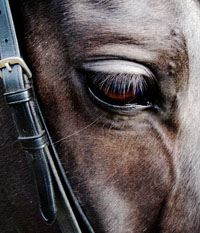- Watch out for the laminitic stance - the horse will attempt to decrease the load on the affected feet, usually the front hooves, it will bring its hindlegs underneath its body and stretch its forelegs out in front.
- Repeated "easing" of affected feet by shifting weight from one foot to another.
- Reluctance to move.
- Walking very tenderly taking small "pottery" steps.
- Repeated "easing" of affected feet by shifting weight from one foot to another.
- Tendency to lie down, whenever possible or, if extreme, to remain lying down.
- Lameness.
- Increased temperature of the wall, sole and/or coronary band of the foot.
- Pounding digital pulse in the pastern.
- Sole of hoof sensitive to pressure
- Anxiety, trembling, sweating, flared nostrils and increased vital signs and body temperature.
Laminitis should be treated as a veterinary emergency and your vet should be called immediately laminitis is suspected.
Urgent veterinary assistance is required.
To receive our monthly horse care tips in your in box simply send us a quick email using Newsletter as the subject. We will only ever send you our newsletters, we won't spam you and we won't share your email with anyone else and you can unsubscribe at any time. Want to see what you'll get, in February we wrote about rodent control Rodent Control around the stableyard / barn - newsletter




